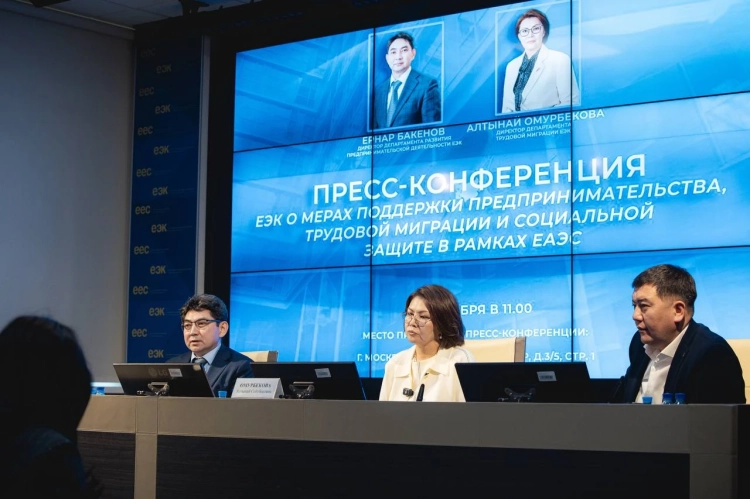
Kyrgyzstan borders one of the most developed regions of Kazakhstan — Almaty. This proximity...

The development of Kyrgyzstan's industry began even before the October Revolution. In 1913,...

Within the framework of the Commonwealth of Independent States, a priority direction for...

Sovereign Kyrgyzstan is an equal member of the international community. One of the most important...

Kyrgyzstan — Uzbekistan...

In Kyrgyzstan, among metalworking enterprises, a repair and mechanical plant was commissioned in...

Kumskova Nailya Khasanovna (1934), Doctor of Economic Sciences (1983), Professor (1984) Tatar....

On December 27, 1991, the Government of the People's Republic of China recognized the...

The foreign ministers of Kazakhstan and Kyrgyzstan have signed a cooperation program for 2014-2015...

A Turn in Social and Political Life. By the mid-1980s, a deep crisis had emerged in all spheres of...

OSH - The textile industry of Kyrgyzstan continues to make progress, providing jobs and economic...

In the first half of 2014, industrial enterprises produced goods worth 65,851.3 million soms, with...

Kyrgyzstan borders Kazakhstan, Uzbekistan, and Tajikistan — friendly states that are close in...
API error: no response...

The share of the forest, woodworking, and pulp and paper industry of the republic in 2000 was: by...

It is well known that private entrepreneurship has become the engine of economic progress in new...

The USA was among the first to recognize the independence of Kyrgyzstan, establishing diplomatic...

Kyrgyzstan, having become an independent state, entered the global community as a developing...

First Wartime Plan On June 30, 1941, the Council of People's Commissars of the USSR approved...

The stable growth dynamics of Kyrgyzstan's economy observed in recent years was interrupted...

In 2013, the development and implementation of technological, marketing, and organizational...

Let’s briefly summarize such an important period as the first 'hundred days' of the...
The IMF has presented its growth forecast for economies around the world, including the Middle East...

The Rosselkhoznadzor has published a list of Kyrgyz enterprises authorized to supply products to...
Non-communicable diseases (NCDs) inflict an economic loss of 29.8 billion soms on the economy of...

Soviet Kyrgyzstan The period when L. Brezhnev was at the head of the state management of the USSR...

The post-Soviet period in the Kyrgyz Republic was marked by dynamic changes. Gaining independence,...

Osh Cotton Production Association The directive of the XXI Congress of the CPSU (1959) reflected...

The communication authorities also improved their work. In a record short time—from July to...

In the political, economic, and spiritual spheres, Kyrgyz-Russian allied interaction has developed...

Today, October 22, Prime Minister of the Kyrgyz Republic Joomart Otorbaev held a meeting with the...

Kamchybekov Tolobek Kadyralievich (1949), Doctor of Economic Sciences (2001), Professor (2002)...

On May 29, 1992, by decree of the President of the Kyrgyz Republic, the units and parts of the...

Kyrgyzstan has deep traditions in the exploration of mineral resources. As early as the beginning...

Today, November 24, 2014, an Agreement was signed between the Government of the Kyrgyz Republic...

When: August 28 at 10:00 AM...

The light industry of Kyrgyzstan encompasses its three sectors: textile, garment, and...

In the photo: Kyrgyz ceramicist Jumagul Tashiev showcases his vases in Bishkek in August. The...

The coup of August 19, 1991. The course of deepening democratic changes in the USSR, conducted by...

After the Turkish Air Force shot down the Russian bomber Su-24, which was participating in the...

The primary task of the Government and the National Bank of Kyrgyzstan (NBK) is financial...
- According to data from the Ministry of Economy and Commerce, the gross output produced by...

A meeting was held at the press center of the Eurasian Economic Commission, featuring Ernard...

The food industry of pre-revolutionary Kyrgyzstan was represented by several small artisanal...

Guided by the principles of creating a unified educational space with neighboring countries,...

Imports to Kyrgyzstan account for approximately a quarter of the total consumption of public goods...

The state of Kyrgyz energy leaves much to be desired; however, in recent years, the situation has...

Today, March 16, 2015, President of the Kyrgyz Republic Almazbek Atambayev met with President of...